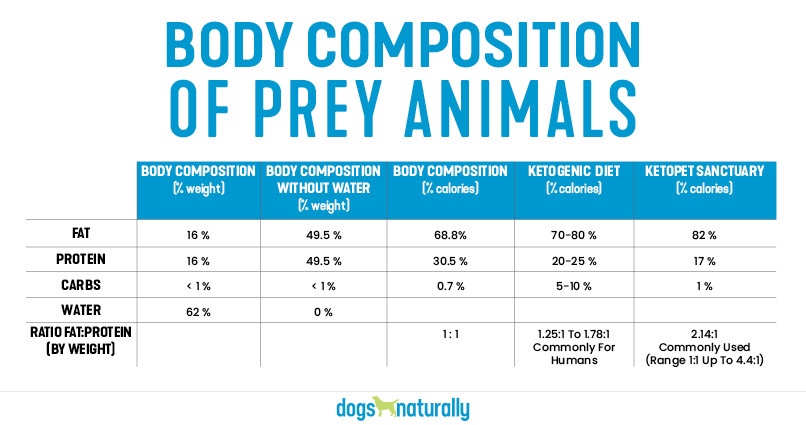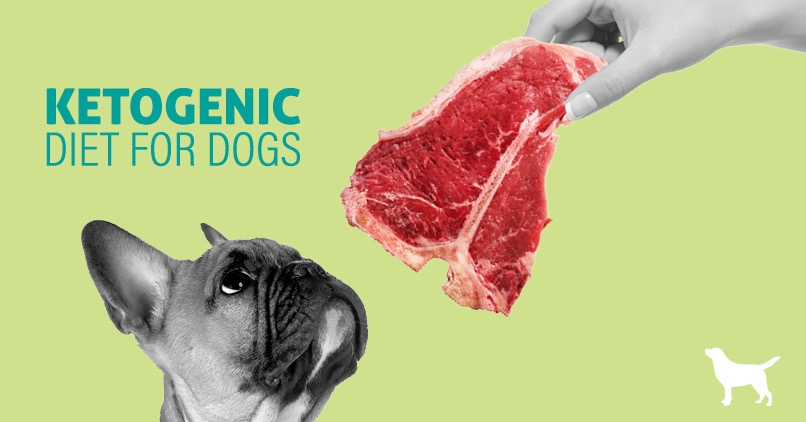The Ketogenic diet for dogs is the “new” kid on the block. Everyone’s talking about it for human health too … but do you know all the ins and outs of why?
There’s a large focus on its impact on disease management and prevention … especially related to cancer.
Knowledge, use, and products supporting this type of diet are dramatically increasing. A simple internet search gives nearly 60 million results … and about 450,000 research articles.
Although mainstream today, ketogenic diets are not really new. They were once prescribed by ancient Greek physicians. They were also popular as an epilepsy treatment in the 1920s and ‘30s … but then new anti-seizure drugs replaced them.
After national media exposure in 1994, keto had a revival … and was even featured in the movie First Do No Harm, starring Meryl Streep.
What Is A Ketogenic Diet?
Keto is a very low-carbohydrate, high fat, moderate protein diet. It forces the body to burn fat for fuel instead of carbohydrates.
But wait! Isn’t that the diet we already feed our carnivorous friends … through species-appropriate meals?
I’ll answer this question a bit later. But first, more about ketogenic diets so that you understand the mechanisms behind it.
How Does It Work?
Healthy cells can use either carbohydrates or fats to produce energy. If a diet is mostly carbs (like kibble and some of the less expensive freeze-dried diets) … the body does one of two things. It converts the carbohydrates to glucose for fuel … or stores the glucose in the liver as glycogen.
But if a diet mainly provides fat – and glycogen stores are low – the body converts that fat into ketones. Ketones are short-chain fatty acids that the body then uses to produce energy.
This is a natural process that induces a metabolic state called ketosis. Don’t confuse this term with life-threatening ketoacidosis sometimes experienced by diabetics. In periods of famine or fasting, ketosis also ensures survival and body functions.
Ketogenic Diet Research
Over the past decades, ketosis research has expanded. As well as drug-resistant epilepsy … studies now explore metabolic diseases like Alzheimer’s, obesity and cancer.
German biochemist Otto Warburg discovered that most cancer cells have altered energy metabolism. They can’t use fat as a source of energy … because they use anaerobic fermentation processes rather than oxygen-based cell respiration.
In 2013, Dr Thomas Seyfried showed that cancer is a metabolic dysfunction of mitochondria … (energy-producing organelles in cells) … triggered by many toxins.
This means that if cancer cells don’t get glucose from carbohydrates or glutamine from protein … they can’t survive and tumor progression slows. This is the reason for the moderate level of protein in ketogenic diets.
So … if the body runs primarily on ketones, it can affect tumor growth. Studies of mice on a ketogenic diet (plus hyperbaric oxygen treatments – HBOT) … show a significant reduction in tumor growth.

KetoPet Sanctuary has numerous case studies documenting the benefits of a ketogenic diet … in combination with HBOT and metabolic conditioning (strenuous exercise).
One of my own patients with a malignant tumor on his tongue is on a ketogenic diet. He was given just a few weeks to live but has been stable … and doing well for the past nine months. Another dog with a big ulcerated anal gland tumor also surpassed all expectations.
The Answer To All Cancers?
We don’t know if keto diets are the answer to all cancers. Likely not, because there are many factors that play a role … including a dog’s overall health.
Some dogs may not be able to digest and tolerate a high-fat diet. Keto is very doable, but there’s a bit of work … and trial and error … in the beginning. You also need to buy a glucose and ketone meter to measure both regularly … to make sure your dog is in ketosis.
RELATED: Is Protein Deficiency Hurting Your Dog?
What Other Benefits Are There?
A ketogenic diet for dogs may have other benefits. In a recent study of 21 epileptic dogs on a keto diet, seven had a 50% reduction in seizure frequency … and three of them became seizure-free.
Several other health benefits can make this diet attractive, even for a healthy dog:
- Reduced inflammation
- Improved fat burning and weight loss
- Blood sugar balancing, especially for diabetic animals
- Improves insulin sensitivity
- Suppresses hunger hormone ghrelin
- Fewer cravings
- Increased and longer-lasting energy
- Improve liver health
- Anti-aging
- Less risk of chronic diseases
- Help with epilepsy and neurodegenerative disorders
- Mitochondrial biogenesis (meaning increased production of mitochondria)
Because there is efficient and cleaner production of energy from ketones than glucose. … with fewer free radicals.
Side Effects Of A Ketogenic Diet
Before you rush out and put your dog on a ketogenic diet, read about some of the side effects it can cause.
- Keto flu: flu-like symptoms and lethargy for a few days. Due to body switching from using carbs to fat (especially if switching to it from high carb diet)
- Diarrhea and constipation
- Possible decrease of microbial diversity in the GI tract
- Pancreatitis (though KetoPet says this is rare for a low-carb diet … because carbs are usually the culprit)
- Picky eaters may not go for it
- Deficiencies due to an imbalanced keto diet
- Muscle atrophy
- More time-consuming (you have to weigh everything, including treats)
- Pricier
- Paradoxical blood glucose elevation (in humans)
- Carbohydrate intolerance (in humans)
RELATED: Raw Feeding Dogs: 10 Simple Rules To Get Started
Is Your Dog On A Ketogenic Diet Already?
So, getting back to the original question I posed … is your dog already eating a ketogenic diet?
In the wild, predatory animals will only consume 3% to 5% carbohydrates.
The Encyclopaedia Britannica says: “The body of a healthy lean man is composed of roughly 62 percent water, 16 percent protein, 6 percent minerals, and less than 1 percent carbohydrate.”
Let’s assume that these numbers come close to what a wild dog would eat when he catches a rabbit.
To make my point, we need to dive into a little bit of calculating. But don’t worry, there’s a benefit: your brain will get its daily exercise!
The numbers I quoted are based on weight. Because ketogenic diet measurements are based on calories … we need to do some converting.
Generally, a ketogenic diet for humans contains 70% to 80% of calories from fat, 20 to 25% from protein and 5 to 10% from carbs.

For dogs, the recommended numbers are a bit different … as you’ll see in the table below.
Ketogenic Diet By Numbers
- Since water doesn’t contain any calories … we adjust the weight percentages to get the numbers in the second column below.
- Next, we convert the weight of fat and protein to calories. Then we compare them with the ketogenic ratios.
- This calculation uses the number of calories per gram of protein (4 kcal), carbs (4 kcal) and fat (9 kcal).
Okay … I did the calculating for you, but I hope you followed my train of thought.
As you’ll see, the body composition of a prey animal in calories (column 3) is very close to a ketogenic diet (columns 4 and 5).

Ketogenic Vs Species-Appropriate Diets
So, carnivores on a species-appropriate diet are already very close to … or even on a ketogenic diet, depending on the actual content of protein and fat.
But the numbers don’t take into account parts of the animal we may not use (brain, skin, etc) or added fiber and carbs from vegetables and fruits … so most premade raw diets are not quite ketogenic.
So … the answer is that your dog is likely very close … but not quite in ketosis. To get fully into ketosis, your dog would usually need more fat and less protein in his diet. (Check KetoPet Sanctuary’s e-book for more details.)
Generally, the recommended ratio of fat to protein by weight (not calories) for dogs with cancer is about 1:1 to 2:1. This range depends on what each dog can tolerate without having gastrointestinal issues.
We’re still left with many questions. We need longer-term studies to tell us how safe and effective keto diets are. As humans we’ve tried many things that turned out to be fads … or even harmful (low-fat foods, artificial sweeteners, drugs).
Choosing What’s Best For Your Dog
To quote novelist Michael R Fletcher:
“Today’s truths will be tomorrow’s lies and you will be left questioning your own sanity.”
But we do the best we can with what we currently know. To err on the safe side for a preventative keto diet in a healthy animal – it may be best to cycle in and out of ketosis… just like nature intended!
RELATED: Is Feeding A Raw Diet Enough?










